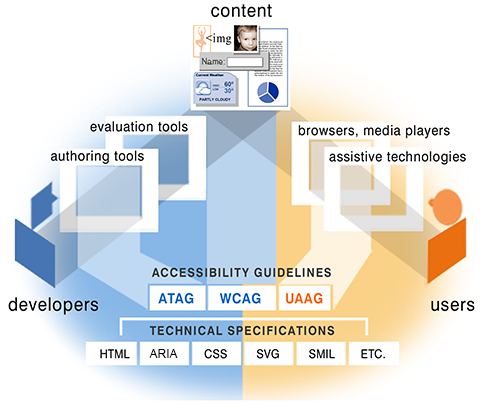Overview of the Web Accessibility Initiative
Daniel Dardailler - Oct 2014
Based on old WAI
Overview
This presentation covers:
- What is Web accessibility?
- Why is Web accessibility important for people with and without
disabilities?
- What is the World Wide Web Consortium doing to address Web
accessibility?
- What resources are available to help make Web sites and Web applications
accessible?
- What actions are useful in promoting Web accessibility?
What is Web Accessibility?
Web accessibility means access to the Web by everyone, regardless of
disability.
Web accessibility includes:
- Web sites and applications
- that people with disabilities can perceive, understand, navigate, and
interact with;
- Web browsers and media players
- that can be used effectively by people with disabilities, and
- that work well with assistive technologies that some people with
disabilities use to access the Web;
- Web authoring tools, and evolving Web technologies
- that support production of accessible Web content and Web sites,
and
- that can be used effectively by people with disabilities.
Technical overview

Why is Web Accessibility an Issue?
There are several reasons why Web accessibility is important:
- use of the Web has spread into all areas of society;
- there are barriers on the Web for many types of disabilities;
- millions of people have disabilities that affect access to the Web;
- some Web sites are required to be accessible;
- Web accessibility also has carry-over benefits for other users.
The next slides explore these reasons in more detail.
Impact of the Web on People with Disabilities
- The Web has become a key resource for:
- news, information, commerce, entertainment,
- classroom education, distance learning,
- job searching, workplace interaction,
- civic participation, government services.
- It is displacing traditional sources of information and interaction --
- schools, libraries, print materials, discourse of the workplace;
- some of the traditional resources were accessible; some not.
- An accessible Web means unprecedented access to information for people
with disabilities.
Web Accessibility is a Cross-Disability Issue
Examples of design requirements for people with different kinds of
disabilities include:
- Visual:
- described graphics or video;
- well marked-up tables or frames;
- keyboard support, screen reader compatibility;
- Hearing:
- captioning for audio, supplemental illustration;
- Physical, Speech:
- keyboard or single-switch support;
- alternatives for speech input on voice portals;
- Cognitive, Neurological:
- consistent navigation, appropriate language level;
- illustration; no flickering or strobing designs.
Web Accessibility is a Marketplace Issue
- At least 10% of the population in most countries has disabilities;
- visual, auditory, physical, speech, cognitive, and neurological
disabilities can all affect access to the Web
- Average age of population in many countries is increasing;
- aging sometimes results in combinations of accessibility issues;
- vision & hearing changes, changes in dexterity & memory.
- Few organizations can afford to deliberately miss this market sector.
Accessibility Contributes to Universal Design
Accessible Web design contributes to better design for other users:
- Multi-modality (support for visual, auditory, tactile access) benefits
users of:
- mobile phones with small display screens, Web-TV, kiosks.
- Multi-modality increases usability of Web sites in different situations:
- low bandwidth (images are slow to download);
- noisy environments (difficult to hear the audio);
- screen-glare (difficult to see the screen);
- driving (eyes and hands are "busy").
- Redundant text/audio/video can support:
- different learning styles; low literacy levels; second-language
access.
- Style sheets can support:
- more efficient page transmission and site maintenance.
- Captioning of audio files supports:
- better machine indexing of content; faster searching of content.
Web Accessibility is Sometimes a Requirement
A number of governments require accessibility of specific kinds of Web
sites.
- often required for government Web sites first;
- sometimes for educational or commercial sites;
- provinces, states, municipalities may have requirements;
- corporations and non-governmental organizations sometimes set own
requirements.
Information on requirements in different countries is available in Policies Relating to Web
Accessibility
W3C Plays Leading Role in Development of Web Technologies
- The World Wide Web Consortium (W3C)
- W3C operates from four host sites:
W3C Hosts the Web Accessibility Initiative (WAI)
- The Web Accessibility Initiative (WAI):
- coordinates with all the other domains of the W3C;
- operates internationally in all three host sites of W3C.
- WAI is sponsored by a variety
of government and industry supporters of accessibility:
- Many organizations from around the world participate in WAI work,
including:
- industry, disability organizations, accessibility research centers,
government, schools and universities,
- and more.
- WAI enables representatives from these different constituencies to:
- work together at the design stage of key Web technologies
- develop accessibility solutions by consensus under W3C Process.
- This process includes:
- collaborative development in W3C working groups;
- extensive opportunities for public comment.
Ensuring that Web Technologies Support Accessibility
The Protocols and Formats Working
Group:
- Ensures that W3C technologies support Web accessibility
- Reviews W3C specifications
- at or before Last Call Working Draft stage
- many technical experts from W3C working groups participate
- Produces requirements statements and review comments
- Is developing WAI-ARIA
Developing Guidelines for Accessibility
Guidelines play a critical role in making the Web accessible, by explaining:
- how to create accessible Web content
- how to design software that supports production of accessible Web
sites
- how to design accessible browsers, and authoring tools
WAI has three different guidelines to address these different needs:
Web Content Accessibility Guidelines
The Web Content Accessibility
Guidelines 2.0
Participation Opportunities in WAI
- WAI Working Groups &
Interest Groups operate under W3C process.
- Work takes place via
e-mail lists, the Web, telephone, and face-to-face meetings.
- Working Groups and Interest Groups include representatives from all
sectors
- Participation requirements, including expertise and commitment level,
vary.
- Most WAI groups have publicly viewable mailing lists.
- All WAI groups welcome comments on draft documents.
- General discussion about Web accessibility
Action Steps to Consider